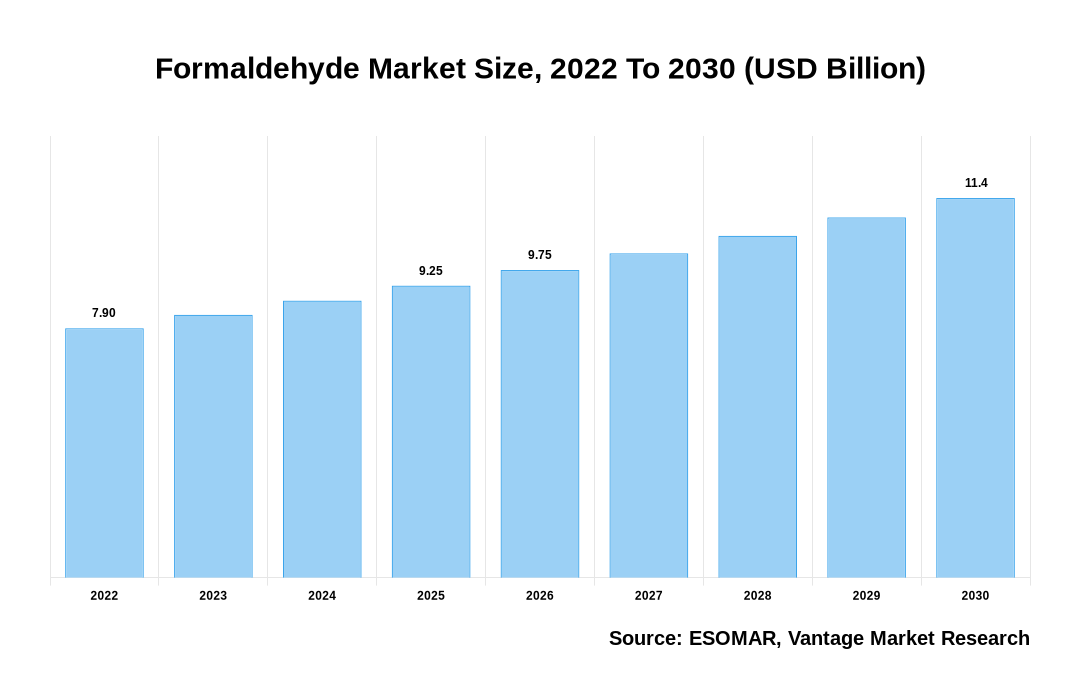Global Formaldehyde Market
As stated in our extensive report; the Global Formaldehyde Market accounted for USD 7.9 Billion in 2022 and is forecast to reach USD 23.1 Billion by 2030 at a CAGR of 5.5%.
Formaldehyde is a crucial component of the substance used to make urea-alkyd resins and is used as a binder in plywood and particle boards with medium densities. Methanol, used mainly to produce resins, is typically used to create Formaldehyde. Numerous sectors use Formaldehyde extensively, including plywood, construction, automotive, and healthcare. The Formaldehyde market has grown significantly due to its high application growth in several sectors, including the automotive, construction, and textile industries. Following this, the increased demand for high-quality plasticizers and the rising demand for paints and coatings are also significant factors supporting the expansion of the Formaldehyde market over the projection period. In addition, the need for Formaldehyde is also expanding due to rising construction expenditure and the quickly expanding automotive sector. The main drivers of market expansion are increasing demand for luxury furniture and a growing desire for specialty fertilizers.
Click To Get a Free Sample On the Research Study

Factors Influencing Global Formaldehyde Market Growth
The growth of the global Formaldehyde market can be attributable to the following:
- Market expansion is anticipated in the future due to Formaldehyde’s expanding use in many end-use sectors, including building and construction, automotive, furniture, textile, healthcare, oil and gas, agriculture, water treatment, and cleaning products.
- The demand for Formaldehyde from the end-use sectors significantly impacts both its production and consumption. Therefore, it is expected that end-use industry demand changes will immediately affect the market.
- Due to its exceptional antibacterial properties, Formaldehyde is also widely used to produce disinfectants, vaccines, and personal care items like toothpaste and mouthwash. Over the forecast period, rising demand for these products will increase Formaldehyde demand.
- Carbon, hydrogen, and oxygen are the components of Formaldehyde. It is well-recognized for both its preservative and antibacterial qualities. It provides outstanding performance and functions as a bonding agent at a reasonable cost when used in end-use applications. This, in turn, is fueling the market’s expansion.
- Due to the lucrative revenue-generating possibilities that Formaldehyde presents to its manufacturers, the United States is one of the top consumers of the substance in the construction industry. Formaldehyde is increasingly being used in producing adhesives and glues for construction applications worldwide, particularly in the United States.
On the other hand, the stringent government regulations, growing health and safety concerns regarding human life, and the accessibility of Formaldehyde-free products could significantly slow the growth of the Formaldehyde market during the forecast period. Additionally, changes in the price of raw materials could threaten the market’s expansion during the forecast period.
Asia Pacific Region to Take Over the Market
The Asia Pacific is predicted to experience the highest development, primarily due to the region’s expanding construction and automotive industries. Furthermore, the demand for Formaldehyde is anticipated to increase during the review period due to favorable government investments in infrastructure growth in emerging Asian nations. Large population base, rising population, and swift end-use industry growth are a few of the aspects driving the Asia Pacific market’s expansion.
Conclusion
The overall Formaldehyde market is benefiting from the increasing use of Formaldehyde in a wide range of end-use sectors, including automotive, building and construction, furniture, textile, healthcare, oil and gas, water treatment, agriculture, and cleaning products.
The well-known players of the Global Formaldehyde Market include Foremark Performance Chemicals (U.S.), Hexion (U.S.), Georgia-Pacific Chemicals (U.S.), Celanese Corporation (U.S.), BASF SE (Germany), Capital Resin Corporation (U.S.), Evonik Industries AG (Germany) and others.
![[Market Research Reports] – Research Google News Blog | VMR.Biz](https://www.vmr.biz/wp-content/uploads/2022/12/logo-removebg-preview.png)











